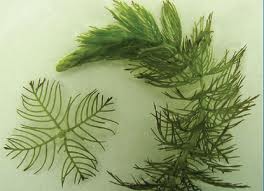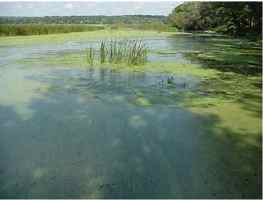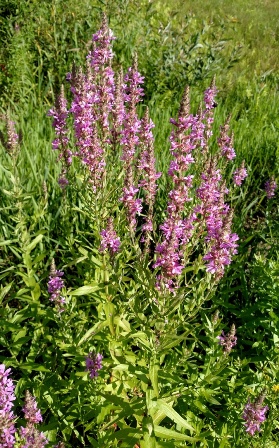Phosphorous
One of the largest threats to both drinking water and recreation is phosphorous contamination. Sources of phosphorus are fertilizer, septic systems, animal feces (including waterfowl), stormwater runoff, lake sediments, lawns, and decaying plant matter. Too much phosphorous leads to murky water and aggressive plant growth. It can cause blooms of toxic cyanobacteria, commonly called blue-green algae, which could close the village water supply and prohibit swimming. Phosphorous contamination generally does not diminish over time – it accumulates, resulting in higher levels of saturation in the lake.
There are many things that landowners can do to minimize phosphorous input to the lake including good septic design, proper septic system maintenance, zero phosphorous fertilizer, native shrubs planted between lawn and lake, and stormwater runoff control. Good sources of information, including many do-it-yourself projects, include NH Lakes LAKESMART Program (https://nhlakes.org/lakesmart) and the NH Department of Environmental Services (NHDES) SOAK UP THE RAIN PROGRAM (https://www4.des.state.nh.us/SoakNH)

E. Coli Bacteria Contamination
In recent years, the public beach has been closed to swimmers on a few occasions due to levels of E. Coli above the New Hampshire guideline, as measured by NH DES. Sources of E. Coli bacteria include septic systems, high number of simultaneous bathers, animal feces (including waterfowl), and stormwater runoff.
Levels of E. Coli in the Lake can be minimized with baby swim diapers, good septic design, proper septic system maintenance, stormwater runoff control, and by not feeding waterfowl.
The New Hampshire Department of Environmental Services has published information about the harm to lakes that feeding Cananda Geese can lead to. Accessible here: https://www.des.nh.gov/blog/april-2022-duck-duck-dont-feed-goose
Invasive weeds
The greatest threat to lake recreation is invasive aquatic weeds, especially milfoil. Invasive weeds are transported between water bodies on boats and equipment, moving from infected water bodies to those that are not yet infected. The nearest milfoil infestations are Mascoma Lake in Enfield, Post Pond in Lyme and The Connecticut River. Should Milfoil become established in our lake, control would be very expensive; and, once introduced, Milfoil is rarely eradicated from an infested water body. Swimming, fishing, and boating can become unpleasant and potentially impossible. It is ILLEGAL to transport and introduce aquatic invasive species in New Hampshire. Violators are subject to fines. (NH RSA 487:16-c – Transport of Aquatic Plants or Exotic Aquatic Weeds on Outside of Boats, vehicles and Equipment).


The Canaan Lake Association participates in two New Hampshire programs to mitigate the risk of an infestation of invasive weeds—The Lake Host Program and the Weed Watching Program.
The Lake Host Program strives to prevent transport of invasive species through free boat inspections at launch ramps, and by educating the public. Two volunteer Program Managers oversee the efforts of numerous volunteers and paid employees in this program.
The Weed Watching Program coordinates monthly surveillance patrols of the entire lake by numerous volunteers whose mission is early identification and reporting of possible infestation by invasive species.
TO PREVENT THE TRANSMISSION OF INVASIVE AQUATIC SPECIES, CLEAN, DRAIN AND DRY BOATS BETWEEN VISITS TO ANY NH LAKE.
Specific actions to take are:
Clean Remove all mud, plants, animals, and debris from your boat, trailer, and equipment. Clean anchors and anchor lines, water intake grates, kayak and canoe cockpits, storage compartments, and paddles. Dispose of all material away from the waterbody where it will not wash back into the water.
Drain State law requires the draining of boats and other water-related equipment after coming out of the water, and leaving plugs and other draining devices open during transport (NH RSA 487:16-d – Draining of Water Conveyances).
After boating, drain water from the boat, including the bilge, live wells, bait buckets, ballast tanks, storage compartments and gear, etc. Do this away from the water’s edge so runoff does not go back into the lake.
Dry Be sure to thoroughly dry anything that contacted lake water.
Between waterbodies
If launching your boat again within 5 days into a different water body, thoroughly rinse boat hull and trailer with clean water where the runoff will not flow back into the lake and towel dry. Rinsing with high pressure, hot water between waterbodies is the gold standard. Flush motor, bilge, live wells, ballast tanks, and storage compartments with clean water per boat manufacturer instructions. It is best to visit a carwash before launching again, especially if the boat has been in a waterbody containing an invasive species infestation.
Reference
http://www.gencourt.state.nh.us/rsa/html/L/487/487-mrg.htm
Cyanobacteria Bloom Information
Cyanobacteria exist in most lakes in New Hampshire but most often the concentration is so low that they don’t pose health risks. Cyanobacteria blooms in high enough concentrations to be a health hazard to people and animals are also called Harmful Algal Blooms. We do not know of any cyanobacteria blooms that have occurred in Canaan Street Lake, but several local lakes have had them.
The link below is to a fact sheet published by the New Hampshire Department of Environmental Services regarding cyanobacteria blooms (including how to report them):
https://www.des.nh.gov/water/healthy-swimming/harmful-algal-blooms
Photos of cyanobacteria blooms
https://www.des.nh.gov/sites/g/files/ehbemt341/files/documents/2020-01/cyano-id-flyer.pdf
A map of beach advisories in New Hampshire can be found at this link:
https://experience.arcgis.com/experience/180c28fa3a4c4371a9771d999454e8c4/
Purple Loosestrife Notice

Here is a link to the NH Department of Environmental Services Fact Sheet about Purple Loosestrife: https://www.des.nh.gov/sites/g/files/ehbemt341/files/documents/2020-01/bb-45.pdf
If you would like help removing Purple Loosestrife from your property, the CLA can help. Please contact us.